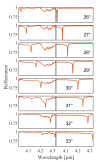Ultra-Narrow SPP Generation from Ag Grating
- PMID: 34770299
- PMCID: PMC8587063
- DOI: 10.3390/s21216993
Ultra-Narrow SPP Generation from Ag Grating
Abstract
In this study, we investigate the potential of one-dimensional plasmonic grating structures to serve as a platform for, e.g., sensitive refractive index sensing. This is achieved by comparing numerical simulations to experimental results with respect to the excitation of surface plasmon polaritons (SPPs) in the mid-infrared region. The samples, silver-coated poly-silicon gratings, cover different grating depths in the range of 50 nm-375 nm. This variation of the depth, at a fixed grating geometry, allows the active tuning of the bandwidth of the SPP resonance according to the requirements of particular applications. The experimental setup employs a tunable quantum cascade laser (QCL) and allows the retrieval of angle-resolved experimental wavelength spectra to characterize the wavelength and angle dependence of the SPP resonance of the specular reflectance. The experimental results are in good agreement with the simulations. As a tendency, shallower gratings reveal narrower SPP resonances in reflection. In particular, we report on 2.9 nm full width at half maximum (FWHM) at a wavelength of 4.12 µm and a signal attenuation of 21%. According to a numerical investigation with respect to a change of the refractive index of the dielectric above the grating structure, a spectral shift of 4122nmRIU can be expected, which translates to a figure of merit (FOM) of about 1421 RIU-1. The fabrication of the suggested structures is performed on eight-inch silicon substrates, entirely accomplished within an industrial fabrication environment using standard microfabrication processes. This in turn represents a decisive step towards plasmonic sensor technologies suitable for semiconductor mass-production.
Keywords: plasmonic grating; reflection measurement; refractive index sensing; surface plasmon polaritons.
Conflict of interest statement
The authors declare no conflict of interest.
Figures








References
-
- Liu Y., Ma Y. One-Dimensional Plasmonic Sensors. Front. Phys. 2020;8:312. doi: 10.3389/fphy.2020.00312. - DOI
Grants and funding
LinkOut - more resources
Full Text Sources
Research Materials
Miscellaneous

